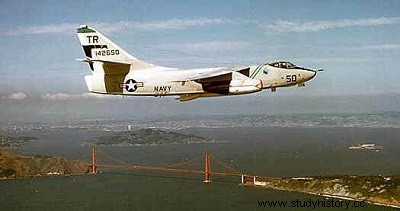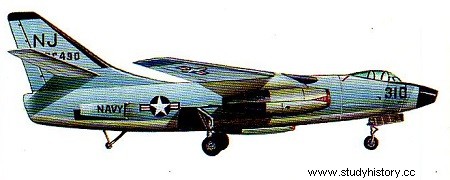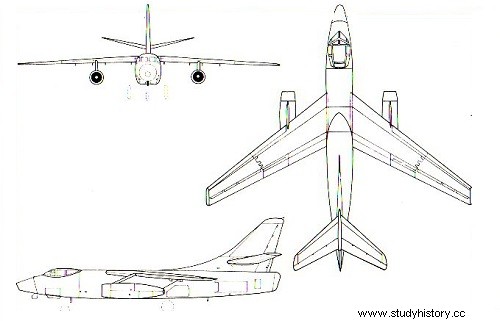
The Skywarrior was the first major strategic bomber with nuclear capabilities to enter service with the US Navy. The 280 units built in total began to equip the detachments in the spring of 1956 and remained in line throughout the sixties. Supplemented in their primary role by about seventy machines intended for reconnaissance, hunting using an electronic countermeasures system and instruction.
In 1947, the US Navy had defined the characteristics of the note that gave birth to the A3D family, but it took until late in the 1950s to be able to move to the operational phase. Indeed, although it immediately set the project in motion, the Douglas did not manage to complete it until two years later. Therefore, on March 31, 1949, the construction order for two prototypes, called XA3D-1, arrived, but the first only flew on October 28, 1952. We must seek the main cause of these relatively long development and production times. in the difficulties inherent in the program:the new bomber was indisputably the largest and heaviest carrier-based aircraft manufactured to date and presented a whole series of specific problems resulting from the particular operational characteristics requested by the Navy. The prototype appeared in the form of a high-winged monoplane, equipped with a fuselage intended almost exclusively to accommodate a considerable war load (5,443 kilos) and electronic equipment:indeed, the three crewmen were housed in a pressurized cabin, placed forward in a very forward position. The engines - originally a couple of Westinghouse J40s, still experimental - were installed in two nacelles, hung under each of the wings, while the defensive armament consisted of only two 20 mm guns located in a controlled turret fitted with a radar, at the very rear of the plane.

Sometime after the first flight of the prototype, as a result of the cancellation of the production program of the J40 engine, replacement propellants had to be found and this research lost another year. Equipped with two Pratt &Whitney J57 turbojet engines, the aircraft, called VA 3D-1, flew for the first time on September 16, 1953 and finally managed to complete the cycle of ground and flight tests. From then on, the Americans started production after having ordered 50 copies of the first series of construction, the A3D-1. These Skywarriors began to arrive in detachments on March 31, 1956 and were used mainly to experiment with the design and operational possibilities of a practically new machine for the Navy.
The United States transformed one of the 50 A3D-1s into a prototype of the future reconnaissance version (YA3D-1P) and modified five others to install the electronic countermeasures system (YA3D-1Q and A3D-1Q). The next model was the A3D-2. It had an improved and enlarged bomb bay, had more powerful engines and could be refueled in flight. The Douglas built 164 A3D-2s which, in 1957, began to equip the heavy bomber detachments of the Midway and Essex category aircraft carriers.
Alongside these bombing machines, the US Navy wanted a series of electronic reconnaissance Skywarriors:this consisted of 30 A3D-2Ps and 24 A3D-2Qs, whose engineers had changed the structure of the fuselage and, sure, the on-board equipment. Production ended with 12 training examples, called A3D-2T and capable of accommodating six students; the first A3D-2T flew on August 29, 1959.
Commitments
After the nuclear bombing mission was abandoned, the A-3s were modified into KA-3s (air-to-air tanker and conventional bomber).
A KA-3 refuels a Supermarine Scimitar F.1 of the Royal Navy under the protection of a Douglas A-4 Skyhawk (1962 or 63)
Vietnam War
It was the first American aircraft to carry out bombing missions in North Vietnam. Subsequently, most KA-3s were used for minelaying missions, but served more extensively as aerial refueling platforms. It was modified in order to be able to refuel both USAF and US Navy aircraft. This type of mission saved more than one crew when they returned from a mission in North Vietnam.
The modification of the KA-3 in EKA-3 gave the possibility to the US Navy to use Skywarrior either for missions of electronic warfare, or for refueling in flight, or both simultaneously. In this type of mission, the A-3 refueled other aircraft while jamming North Vietnamese radars.
Cold War
Like the EB-66, the EKA-3 was also used extensively to spy on Eastern countries, as well as China. It was also used during Operation Desert Storm, which was its last operational mission.
Variants
A-3 (A3D-1):Carrier-based strategic bomber
EA-3(A3D-1 Q):Electronic warfare version
EKA-3:34 KA -3 modified into air tanker and electronic warfare
KA-3:A-3 modified into tanker (removal of bombing equipment)
NA-3:aircraft modified for radar test and missile firing. 2 copies participated among others in the AIM-54 Phoenix program
NKA-3:KA-3 modified for radar test
TA-3 (A3D-2T):Version trainer, equipped to train 4 radar/electronic warfare operators
B-66:Version intended for the USAF.
dates
commissioning date :1954
date of end of use :1991
Nationalities
Constructor :USA
Users :US Navy
Categories Strategic Bomber
Number built 282

Technical and Performance Data
Wingspan :22.10 m.
Length :23.26 m.
Height :6.94 m
Maximum Weight :37,195 kg.
Maximum Altitude :12,500 m
Range :1,690 km
Maximum speed :981 km/h at 3,048 m
Motorisation (engines or reactors)
 two Pratt &Whitney J57-P-10 turbojet engines with 5,625 kg of thrust
two Pratt &Whitney J57-P-10 turbojet engines with 5,625 kg of thrust
Armaments
 2x 20mm guns, 5,443kg war load
2x 20mm guns, 5,443kg war load
 3 people
3 people
